Courses


 Compare
Compare
Geomorphic Processes is a Class 11 course that explores the natural forces that shape the Earth's surface. It delves into the processes of weathering, erosion, transportation, and deposition, which together create the diverse landscapes we see today. জিওমর্ফিক প্রসেস হল একাদশ শ্রেণীর একটি কোর্স যা পৃথিবীর পৃষ্ঠকে রূপদানকারী প্রাকৃতিক শক্তির অন্বেষণ করে। এটি আবহাওয়া, ক্ষয়, পরিবহন এবং নিক্ষেপণের প্রক্রিয়াগুলির মধ্যে অনুসন্ধান করে, যা একসাথে আমরা আজ যে বৈচিত্র্যময় প্রাকৃতিক দৃশ্য দেখি তা তৈরি করে।
₹599
0 Lessons
Hours
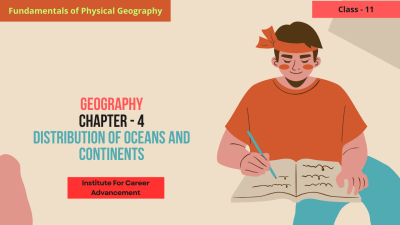
 Compare
Compare
Distribution of Oceans and Continents is a Class 11 course that explores the spatial patterns of the Earth's landmasses and bodies of water. It delves into the distribution of continents and oceans, their characteristics, and the factors that influence their formation and distribution. মহাসাগর এবং মহাদেশগুলির বিতরণ হল একাদশ শ্রেণীর একটি কোর্স যা পৃথিবীর স্থলভাগ এবং জলাশয়ের স্থানিক নিদর্শনগুলি অন্বেষণ করে। এটি মহাদেশ এবং মহাসাগরের বিতরণ, তাদের বৈশিষ্ট্য এবং তাদের গঠন ও বিতরণকে প্রভাবিত করে এমন কারণগুলির মধ্যে অনুসন্ধান করে।
₹599
0 Lessons
Hours
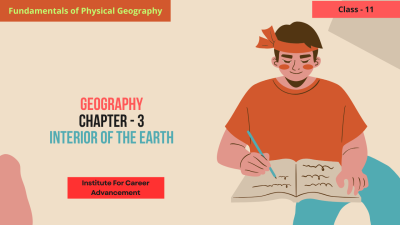
 Compare
Compare
Interior of the Earth is a Class 11 course that explores the structure, composition, and processes happening deep within our planet. It delves into the layers of the Earth, their properties, and the forces that shape them. পৃথিবীর অভ্যন্তর হল একাদশ শ্রেণীর একটি কোর্স যা আমাদের গ্রহের গভীরে ঘটে যাওয়া কাঠামো, গঠন এবং প্রক্রিয়াগুলি অন্বেষণ করে। এটি পৃথিবীর স্তর, তাদের বৈশিষ্ট্য এবং তাদের গঠনকারী শক্তিগুলির মধ্যে অনুসন্ধান করে।
₹599
1 Lessons
Hours
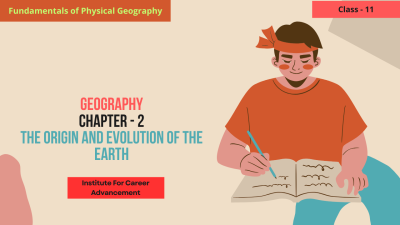
 Compare
Compare
The Origin and Evolution of the Earth is a Class 11 course that explores the formation and development of our planet. It delves into scientific theories about the Earth's creation, its geological processes, and how it has changed over billions of years. This course provides a comprehensive understanding of the Earth's history and the forces that have shaped its current state. পৃথিবীর উৎপত্তি এবং বিবর্তন একটি একাদশ শ্রেণীর কোর্স যা আমাদের গ্রহের গঠন এবং বিকাশের অন্বেষণ করে। এটি পৃথিবীর সৃষ্টি, এর ভূতাত্ত্বিক প্রক্রিয়া এবং কোটি কোটি বছর ধরে এটি কীভাবে পরিবর্তিত হয়েছে সে সম্পর্কে বৈজ্ঞানিক তত্ত্বগুলি অনুসন্ধান করে। এই কোর্সটি পৃথিবীর ইতিহাস এবং এর বর্তমান অবস্থাকে রূপদানকারী শক্তিগুলির একটি বিস্তৃত ধারণা প্রদান করে।
₹599
0 Lessons
Hours

 Compare
Compare
Geography as a Discipline is a Class 12 course that explores the study of the Earth's physical and human environments. It delves into various aspects of geography, including physical features, climate, natural resources, population distribution, human activities, and their interactions. This course provides a comprehensive understanding of the spatial patterns and processes shaping our planet. একটি শৃঙ্খলা হিসাবে ভূগোল হল দ্বাদশ শ্রেণির একটি কোর্স যা পৃথিবীর প্রাকৃতিক এবং মানব পরিবেশের অধ্যয়নের অন্বেষণ করে। এটি ভৌগলিক বৈশিষ্ট্য, জলবায়ু, প্রাকৃতিক সম্পদ, জনসংখ্যার বন্টন, মানুষের ক্রিয়াকলাপ এবং তাদের মিথস্ক্রিয়া সহ ভূগোলের বিভিন্ন দিক নিয়ে আলোচনা করে। এই কোর্সটি আমাদের গ্রহকে রূপদানকারী স্থানিক নিদর্শন এবং প্রক্রিয়াগুলির একটি বিস্তৃত ধারণা প্রদান করে।
₹599
1 Lessons
Hours
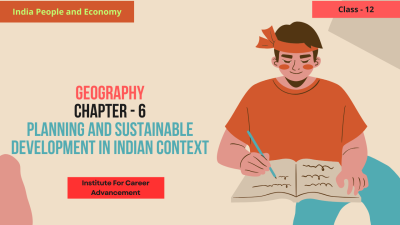
 Compare
Compare
Planning and Sustainable Development in the Indian Context is a Class 12 course that explores the concepts of sustainable development and its relevance to India. It delves into the planning process in India, its evolution over time, and its effectiveness in achieving sustainable development goals. The course also examines the challenges and opportunities facing India in its pursuit of sustainability, promoting critical thinking and problem-solving skills related to planning and development. ভারতীয় প্রেক্ষাপটে পরিকল্পনা ও টেকসই উন্নয়ন হল দ্বাদশ শ্রেণির একটি কোর্স যা টেকসই উন্নয়নের ধারণা এবং ভারতের সাথে এর প্রাসঙ্গিকতা অন্বেষণ করে। এটি ভারতে পরিকল্পনা প্রক্রিয়া, সময়ের সাথে এর বিবর্তন এবং টেকসই উন্নয়ন লক্ষ্য অর্জনে এর কার্যকারিতা নিয়ে গভীরভাবে আলোচনা করে। কোর্সটি টেকসইতা, সমালোচনামূলক চিন্তাভাবনা এবং পরিকল্পনা ও উন্নয়নের সাথে সম্পর্কিত সমস্যা সমাধানের দক্ষতার প্রচারে ভারতের মুখোমুখি চ্যালেঞ্জ এবং সুযোগগুলিও পরীক্ষা করে।
₹599
0 Lessons
Hours
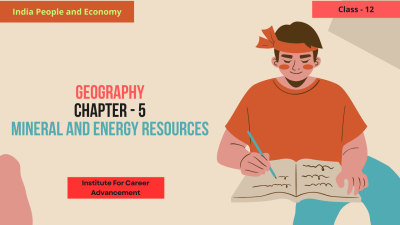
 Compare
Compare
Mineral resources are inorganic substances found in the Earth's crust. They are essential for various industries and our daily lives. These resources can be classified into two main categories: Metallic minerals: These contain metals, such as iron, copper, gold, and aluminum. They are used in manufacturing, construction, and technology. Non-metallic minerals: These do not contain metals, such as coal, petroleum, natural gas, limestone, and mica. They are used for energy production, construction materials, and industrial processes. Energy resources are the sources of power used to perform various tasks. They can be classified into two types: Renewable energy resources: These can be replenished naturally, such as solar, wind, hydro, geothermal, and biomass. Non-renewable energy resources: These are finite and cannot be regenerated within a human lifespan, such as coal, petroleum, and natural gas. Geographic distribution: India is rich in various mineral and energy resources, including iron ore, coal, bauxite, and natural gas. However, it also faces challenges such as depletion of some resources and dependence on imports for others. By understanding the concepts of mineral and energy resources, their distribution, and the challenges associated with their use, students can develop a deeper appreciation for the importance of these resources in our society and the need for sustainable practices. খনিজ সম্পদ হল পৃথিবীর ভূত্বকের মধ্যে পাওয়া অজৈব পদার্থ। এগুলি বিভিন্ন শিল্প এবং আমাদের দৈনন্দিন জীবনের জন্য প্রয়োজনীয়। এই সম্পদগুলিকে দুটি প্রধান বিভাগে শ্রেণীবদ্ধ করা যেতে পারেঃ ধাতব খনিজঃ এগুলিতে লোহা, তামা, সোনা এবং অ্যালুমিনিয়ামের মতো ধাতু থাকে। এগুলি উৎপাদন, নির্মাণ এবং প্রযুক্তিতে ব্যবহৃত হয়। অ-ধাতব খনিজঃ এগুলিতে কয়লা, পেট্রোলিয়াম, প্রাকৃতিক গ্যাস, চুনাপাথর এবং অভ্রের মতো ধাতু থাকে না। এগুলি শক্তি উৎপাদন, নির্মাণ সামগ্রী এবং শিল্প প্রক্রিয়াগুলির জন্য ব্যবহৃত হয়। শক্তি সম্পদ হল শক্তির উৎস যা বিভিন্ন কাজ সম্পাদনের জন্য ব্যবহৃত হয়। এদেরকে দুই শ্রেণীতে ভাগ করা যায়ঃ পুনর্নবীকরণযোগ্য শক্তি সম্পদঃ এগুলি প্রাকৃতিকভাবে পুনরায় পূরণ করা যেতে পারে, যেমন সৌর, বায়ু, জলবিদ্যুৎ, ভূ-তাপীয় এবং জৈববস্তুপুঞ্জ। অ-পুনর্নবীকরণযোগ্য শক্তি সম্পদঃ এগুলি সীমাবদ্ধ এবং কয়লা, পেট্রোলিয়াম এবং প্রাকৃতিক গ্যাসের মতো মানুষের জীবনকালের মধ্যে পুনরুত্পাদন করা যায় না। ভৌগোলিক বণ্টনঃ ভারত লৌহ আকরিক, কয়লা, বক্সাইট এবং প্রাকৃতিক গ্যাস সহ বিভিন্ন খনিজ ও শক্তি সম্পদে সমৃদ্ধ। তবে, এটি কিছু সম্পদ হ্রাস এবং অন্যদের জন্য আমদানির উপর নির্ভরতার মতো চ্যালেঞ্জেরও মুখোমুখি হয়। খনিজ ও শক্তি সম্পদের ধারণাগুলি, তাদের বিতরণ এবং তাদের ব্যবহারের সাথে সম্পর্কিত চ্যালেঞ্জগুলি বোঝার মাধ্যমে, শিক্ষার্থীরা আমাদের সমাজে এই সংস্থানগুলির গুরুত্ব এবং টেকসই অনুশীলনের প্রয়োজনীয়তার জন্য গভীর উপলব্ধি বিকাশ করতে পারে।
0 Lessons
Hours

 Compare
Compare
Water Resources is a study of the availability, distribution, management, and utilization of water resources on Earth. This includes understanding the hydrological cycle, different water sources (surface and groundwater), water scarcity issues, and the importance of water conservation. জল সম্পদ হল পৃথিবীতে জল সম্পদের প্রাপ্যতা, বন্টন, ব্যবস্থাপনা এবং ব্যবহারের একটি অধ্যয়ন। এর মধ্যে রয়েছে জলবিদ্যুৎ চক্র, বিভিন্ন জলের উৎস (পৃষ্ঠ এবং ভূগর্ভস্থ জল) জলের ঘাটতি সমস্যা এবং জল সংরক্ষণের গুরুত্ব বোঝা।
0 Lessons
Hours

 Compare
Compare
This topic explores the crucial relationship between land and agriculture. It examines how land is used for agricultural production, the challenges faced in land management, and the importance of sustainable agricultural practices. Key areas include: Land as a resource: its types, distribution, and utilization. Agricultural practices: traditional and modern methods. Land degradation and conservation measures. Crop patterns and their geographical distribution. Agricultural productivity and challenges. Understanding land resources and agriculture is essential for comprehending food security, rural development, and environmental sustainability. এই বিষয়টি জমি এবং কৃষির মধ্যে গুরুত্বপূর্ণ সম্পর্ক অন্বেষণ করে। এটি কৃষি উৎপাদনের জন্য জমি কীভাবে ব্যবহার করা হয়, ভূমি ব্যবস্থাপনায় কী কী চ্যালেঞ্জের মুখোমুখি হয় এবং টেকসই কৃষি পদ্ধতির গুরুত্ব পরীক্ষা করে। মূল ক্ষেত্রগুলির মধ্যে রয়েছেঃ সম্পদ হিসেবে জমিঃ এর ধরন, বন্টন এবং ব্যবহার। কৃষি পদ্ধতিঃ ঐতিহ্যবাহী এবং আধুনিক পদ্ধতি। ভূমি অবক্ষয় ও সংরক্ষণ ব্যবস্থা। ফসলের ধরণ এবং তাদের ভৌগোলিক বন্টন। কৃষি উৎপাদনশীলতা ও চ্যালেঞ্জ খাদ্য নিরাপত্তা, গ্রামীণ উন্নয়ন এবং পরিবেশগত স্থায়িত্ব বোঝার জন্য ভূমি সম্পদ ও কৃষিকে বোঝা অপরিহার্য।
₹599
0 Lessons
Hours